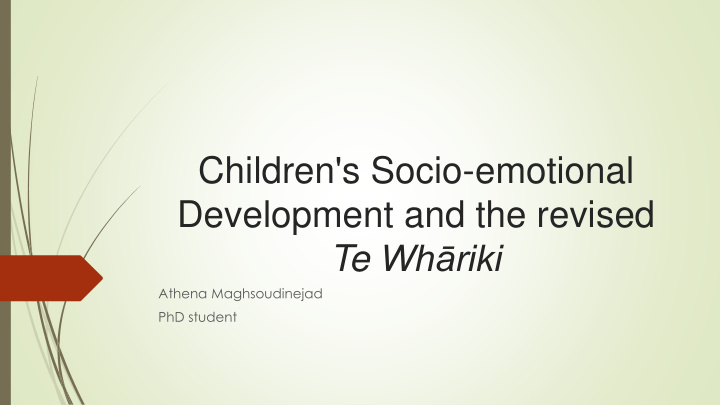



Children's Socio-emotional Development and the revised Te Whāriki Athena Maghsoudinejad PhD student
What does bullying look like in early childhood education settings? Despite a growing international body of evidence which has demonstrated that bullying behaviour occurs frequently in early childhood education (Alsaker & Gutzwiller-Helfenfinger, 2010; Alsaker & Nägele, 2008; Kirves & Sajaniemi, 2012; Monks & Smith, 2010). Little is still known about the nature of this phenomenon and its roots in ECE universally.
Definition of Bullying in ECE There is a debate about applying the Bullying definition to young children, due to the instability of social skills that characterize this age. For example, studies have determined that victims in early childhood experience victimization only for a brief period of time compared to school-age children who are repeatedly victimized over a long period of time (Kochenderfer & Ladd, 1997; Monks, Ortega Ruiz, & Torrado Val, 2002). According to Hanish et al. (2004), young bullies are those whose behaviour is more frequently aggressive compared to children of a similar age. Therefore, there is some argument that the term ‘ bully- like ’ behaviours or ‘ unjustified aggression ’ might be more appropriate for describing ‘ bullying ’ in an early childhood setting.
Socio-ecological Model ( Bronfenbrenner,1977; Espelage & Swearer, 2004 ) Culture Community School Peers Family Bully or Victim
EC teacher’s role in children’s socio - emotional wellbeing Children with a secure teacher-child relationship tend to have more positive peer relationships (Raikes, 1996). The third strand of Te Whariki (Contribution) emphasizes the important role that EC teachers have in helping children initiate and maintain their peer relationships. By interacting with others, children learn to take another’s point of view , empathise , ask for help , help others and learn how to discuss or explain their ideas.
Why is parenting style important? Lereya, Samara, & Wolke, (2013) found that family-child interactions play a significant role in protecting children and adolescents against peer victimization . In particular, high parental involvement and support , warm and affectionate relationships, and good family communication and supervision were all beneficial. However, “ abuse and neglect and maladaptive parenting were the best predictors of victim or bully/victim status at school” (p.12)
Research Aims The focus of this research is on teachers’ and parents’ understanding of children’s bully -like behaviours in early childhood settings in order to find: 1. The extent to which hypothetical scenarios were labelled as bully-like behaviour 2. The perceived seriousness of the bully-like behaviour 3. The likelihood of intervention 4. The likely intervention strategy that would be selected in order to deal with the situations.
An example of a hypothetical scenario Maryam who is 4 years old, has been in the centre since she was 2 years old. Tara who is 3 ½ years old, was a newcomer and was keen to find a playmate. Maryam told her friends to stay away from Tara because “Tara isn’t cool”. Now, whenever Tara tries to play with Maryam or one of Maryam’s friends, they say “No, we’re too busy”. Tara feels left out and doesn’t know why they won’t play with her.
Significant of the research It is anticipated that the information gained from this research will help us to get a better understanding of bully-like behaviours in early childhood . We can then begin to develop evidence based early intervention programmes to prevent the development of school based bullying and victimization .
References Hanish, L. D., Eisenberg, N., Fabes, R. A., Spinrad, T. L., Ryan, P., & Schmidt, S. (2004). The expression and regulation of negative emotions: Risk factors for young children's peer victimization. Development and psychopathology, 16(02), 335-353. Kirves, L., & Sajaniemi, N. (2012). Bullying in early educational settings. Early child development and care, 182(3-4), 383-400. doi:10.1080/03004430.2011.646724. Lereya, S. T., Samara, M., & Wolke, D. (2013). Parenting behaviour and the risk of becoming a victim and a bully/victim: A meta-analysis study. Child abuse & neglect, 37(12), 1091-1108. Alsaker, F. D., & Gutzwiller-Helfenfinger, E. (2010). Social behavior and peer relationships of victims, bully-victims, and bullies in kindergarten. The handbook of school bullying. An international perspective , 87-99. Alsaker, F. D., & Valkanover, S. (2001). Early diagnosis and prevention of victimization in kindergarten. Peer harassment in school: The plight of the vulnerable and victimized , 175-195. Monks, & Smith, P. K. (2010). Peer, self and teacher nominations of participant roles taken in victimisation by five-and eight-year-olds. Journal of aggression, conflict and peace research, 2 (4), 4-14. Kochenderfer, B. J., & Ladd, G. W. (1997). Victimized children's responses to peers' aggression: Behaviors associated with reduced versus continued victimization. Development and psychopathology, 9 (01), 59-73. Monks, Ortega Ruiz, R., & Torrado Val, E. (2002). Unjustified aggression in preschool. Aggressive Behavior, 28 (6), 458- 476. Bronfenbrenner, U. (1979). The Ecology of Human Development : Cambridge, MA: Harvard University Press. Raikes, H. (1996). A secure base for babies: Applying attachment concepts to the infant care setting. Young Children, 51 (5), 59-67.
Thank you for your attention. Any Questions?
Recommend
More recommend